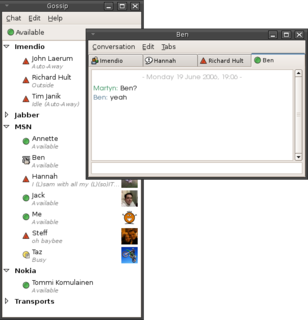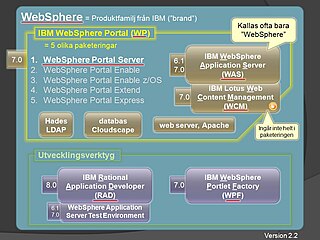
SOAP is a messaging protocol specification for exchanging structured information in the implementation of web services in computer networks. It uses XML Information Set for its message format, and relies on application layer protocols, most often Hypertext Transfer Protocol (HTTP), although some legacy systems communicate over Simple Mail Transfer Protocol (SMTP), for message negotiation and transmission.

Instant messaging (IM) technology is a type of online chat allowing real-time text transmission over the Internet or another computer network. Messages are typically transmitted between two or more parties, when each user inputs text and triggers a transmission to the recipient(s), who are all connected on a common network. It differs from email in that conversations over instant messaging happen in real-time. Most modern IM applications use push technology and also add other features such as emojis, file transfer, chatbots, voice over IP, or video chat capabilities.
A web service (WS) is either:
In software engineering, software configuration management is the task of tracking and controlling changes in the software, part of the larger cross-disciplinary field of configuration management. SCM practices include revision control and the establishment of baselines. If something goes wrong, SCM can determine the "what, when, why and who" of the change. If a configuration is working well, SCM can determine how to replicate it across many hosts.

Typesetting is the composition of text by means of arranging physical type in mechanical systems or glyphs in digital systems representing characters. Stored types are retrieved and ordered according to a language's orthography for visual display. Typesetting requires one or more fonts. One significant effect of typesetting was that authorship of works could be spotted more easily, making it difficult for copiers who have not gained permission.
The Organization for the Advancement of Structured Information Standards is a nonprofit consortium that works on the development, convergence, and adoption of open standards for cybersecurity, blockchain, Internet of things (IoT), emergency management, cloud computing, legal data exchange, energy, content technologies, and other areas.

IBM WebSphere refers to a brand of proprietary computer software products in the genre of enterprise software known as "application and integration middleware". These software products are used by end-users to create and integrate applications with other applications. IBM WebSphere has been available to the general market since 1998.
Enterprise application integration (EAI) is the use of software and computer systems' architectural principles to integrate a set of enterprise computer applications.
HCL Sametime Premium is a client–server application and middleware platform that provides real-time, unified communications and collaboration for enterprises. Those capabilities include presence information, enterprise instant messaging, web conferencing, community collaboration, and telephony capabilities and integration. Currently it is developed and sold by HCL Software, a division of Indian company HCL Technologies, until 2019 by the Lotus Software division of IBM.

An enterprise service bus (ESB) implements a communication system between mutually interacting software applications in a service-oriented architecture (SOA). It represents a software architecture for distributed computing, and is a special variant of the more general client-server model, wherein any application may behave as server or client. ESB promotes agility and flexibility with regard to high-level protocol communication between applications. Its primary use is in enterprise application integration (EAI) of heterogeneous and complex service landscapes.
Microsoft BizTalk Server is an inter-organizational middleware system (IOMS) that automates business processes through the use of adapters which are tailored to communicate with different software systems used in an enterprise. Created by Microsoft, it provides enterprise application integration, business process automation, business-to-business communication, message broker and business activity monitoring.

In a computer system or network, a runbook is a compilation of routine procedures and operations that the system administrator or operator carries out. System administrators in IT departments and NOCs use runbooks as a reference.
A mashup, in web development, is a web page or web application that uses content from more than one source to create a single new service displayed in a single graphical interface. For example, a user could combine the addresses and photographs of their library branches with a Google map to create a map mashup. The term implies easy, fast integration, frequently using open application programming interfaces and data sources to produce enriched results that were not necessarily the original reason for producing the raw source data. The term mashup originally comes from creating something by combining elements from two or more sources.
An XML appliance is a special-purpose network device used to secure, manage and mediate XML traffic. They are most popularly implemented in service-oriented architectures (SOA) to control XML-based web services traffic, and increasingly in cloud-oriented computing to help enterprises integrate on premises applications with off-premises cloud-hosted applications. XML appliances are also commonly referred to as SOA appliances, SOA gateways, XML gateways, and cloud brokers. Some have also been deployed for more specific applications like Message-oriented middleware. While the originators of the product category deployed exclusively as hardware, today most XML appliances are also available as software gateways and virtual appliances for environments like VMWare.
IBM App Connect Enterprise is IBM's premier integration software offering, allowing business information to flow between disparate applications across multiple hardware and software platforms. Rules can be applied to the data flowing through user-authored integrations to route and transform the information. The product can be used as an Enterprise Service Bus supplying a communication channel between applications and services in a service-oriented architecture.
MessagePlus/Open is a communication platform for medium to large organizations designed specifically to handle high volumes of traffic within a high-availability environment. Currently supported communication channels include fax, fax over IP, e-mail and SMS, together withvarious options for integration with business applications. The product has been developed by INTERCOPE GmbH, Germany and is sold by both Intercope and IBM. It was previously known as FaxPlus/Open.

A computer appliance is a home appliance with software or firmware that is specifically designed to provide a specific computing resource. Such devices became known as appliances because of the similarity in role or management to a home appliance, which are generally closed and sealed, and are not serviceable by the user or owner. The hardware and software are delivered as an integrated product and may even be pre-configured before delivery to a customer, to provide a turn-key solution for a particular application. Unlike general purpose computers, appliances are generally not designed to allow the customers to change the software and the underlying operating system, or to flexibly reconfigure the hardware.
IBM WebSphere DataPower SOA Appliances is a family of pre-built, pre-configured rack-mountable network devices that can help accelerate XML and Web Services deployments while extending SOA infrastructure. Originally these devices were created by DataPower Technology Inc., which was acquired by IBM in October 2005.
IBM Forms is a suite of products by IBM's Lotus Software division that interact to develop and deliver data-driven, XML-based electronic forms (e-forms) to end-users. IBM Forms consists of a server, designer, and client viewer that enable creation, deployment, and streamlining of forms-based processes. IBM Forms originally used Extensible Forms Description Language (XFDL) as the format for its electronic forms, and it has gradually added XForms to XFDL as that standard has matured.

Information technology (IT) is the use of computers to create, process, store, retrieve, and exchange all kinds of data and information. IT forms part of information and communications technology (ICT). An information technology system is generally an information system, a communications system, or, more specifically speaking, a computer system — including all hardware, software, and peripheral equipment — operated by a limited group of IT users.







